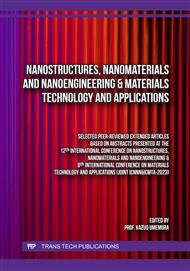[1]
Ho, T.-C., Chang, C.-C., Chan, H.-P., Chung, T.-W., Shu, C.-W., Chuang, K.-P., Duh, T.-H., Yang, M.-H., & Tyan, Y.-C. (2022). Hydrogels: Properties and applications in Biomedicine. Molecules, 27(9), 2902
DOI: 10.3390/molecules27092902
Google Scholar
[2]
Kailasa, S. K., Joshi, D. J., Kateshiya, M. R., Koduru, J. R., & Malek, N. I. (2022). Review on the biomedical and sensing applications of nanomaterial-incorporated hydrogels. Materials Today Chemistry, 23, 100746
DOI: 10.1016/j.mtchem.2021.100746
Google Scholar
[3]
Romruen, O.; Kaewprachu, P.; Karbowiak, T.; Rawdkuen, S. Isolation and Characterization Cellulose Nanosphere from Different Agricultural By-Products. Polymers 2022, 14, 2534
DOI: 10.3390/polym14132534
Google Scholar
[4]
Chawla, P., Sridhar, K., Kumar, A., Sarangi, P. K., Bains, A., & Sharma, M. (2023). Production of nanocellulose from corn husk for the development of antimicrobial biodegradable packaging film. International Journal of Biological Macromolecules, 242, 124805
DOI: 10.1016/j.ijbiomac.2023.124805
Google Scholar
[5]
Yang, X., Han, F., Xu, C., Jiang, S., Huang, L., Liu, L., & Xia, Z. (2017). Effects of preparation methods on the morphology and properties of nanocellulose (NC) extracted from corn husk. Industrial Crops and Products. 109 (2017), pp.241-247
DOI: 10.1016/j.indcrop.2017.08.032
Google Scholar
[6]
Karakurt I., Aydogdu A., Cikrikci, S., Orozco, J., & Lin, L. (2020). Strereolithography (SLA) 3D printing of ascorbic acid loaded hydrogels: A controlled release study. International Journal of Pharmaceutics, 584 119428.
DOI: 10.1016/j.ijpharm.2020.119428
Google Scholar
[7]
Raza, M., Abu-Jdayil, B., Banat, F., & Al-Marzouqi, A. H. (2022). Isolation and characterization of cellulose nanocrystals from date palm waste. ACS Omega, 7(29), 25366–25379
DOI: 10.1021/acsomega.2c02333
Google Scholar
[8]
Ilyas, R.; Sapuan, S.; Ishak, M. Isolation and characterization of nanocrystalline cellulose from sugar palm fibres (Arenga pinnata). Carbohydr. Polym. 2018, 181, 1038−1051.
DOI: 10.1016/j.carbpol.2017.11.045
Google Scholar
[9]
Agustin, M. B., Ahmmad, B., De Leon, E. R., Buenaobra, J. L., Salazar, J. R., & Hirose, F. (2013). Starch-based biocomposite films reinforced with cellulose nanocrystals from garlic stalks. Polymer Composites, 34(8), 1325–1332
DOI: 10.1002/pc.22546
Google Scholar
[10]
Kaushik, M., Fraschini, C., Chauve, G., & Moores, J.-L. P. A. (2015, September 2). Transmission electron microscopy for the characterization of cellulose nanocrystals. IntechOpen. https://www.intechopen.com/chapters/48864
DOI: 10.5772/60985
Google Scholar
[11]
Qian, H. (2021, September 28). Major factors influencing the size distribution analysis of cellulose nanocrystals imaged in transmission electron microscopy. Polymers. https://www.ncbi.nlm.nih.gov/pmc/articles/PMC8513063/
DOI: 10.3390/polym13193318
Google Scholar
[12]
Amin, K. N., Hosseinmardi, A., Martin, D. J., & Annamalai, P. K. (2022). A mixed acid methodology to produce thermally stable cellulose nanocrystal at high yield using phosphoric acid. Journal of Bioresources and Bioproducts, 7(2), 99–108
DOI: 10.1016/j.jobab.2021.12.002
Google Scholar
[13]
Lam, D.-N., Thien, D. V., Nguyen, C.-N., Nguyen, N. T., Van Viet, N., & Van-Pham, D.-T. (2022). Thermally stable cellulose nanospheres prepared from office waste paper by complete removal of hydrolyzed sulfate groups. Carbohydrate Polymers, 297, 120009
DOI: 10.1016/j.carbpol.2022.120009
Google Scholar
[14]
Burke, G., Barron, V., Geever, T., Geever, L., Devine, D. M., & Higginbotham, C. L. (2019). Evaluation of the materials properties, stability and cell response of a range of PEGDMA hydrogels for tissue engineering applications. Journal of the Mechanical Behavior of Biomedical Materials, 99, 1–10
DOI: 10.1016/j.jmbbm.2019.07.003
Google Scholar



